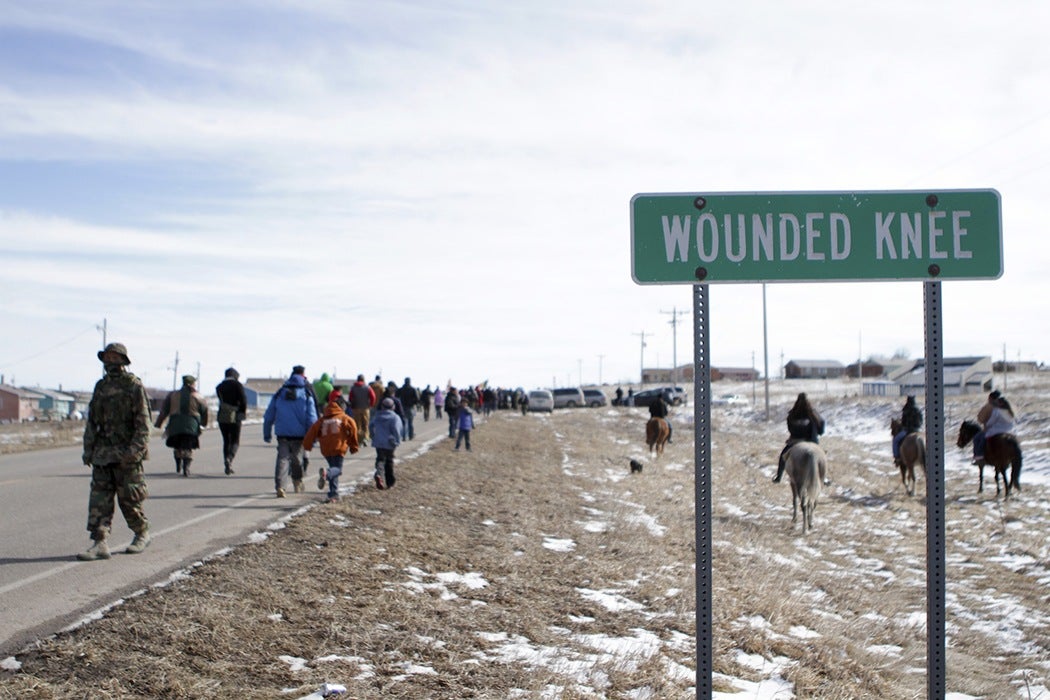This December 29th marks the 126th anniversary of The Big Foot Massacre, also known as the Massacre at Wounded Knee or the Battle at Wounded Knee. In 1890, after 100 years of government policies and over 300 treaties stripping indigenous Americans of their land and rights, a violent and seemingly final standoff occurred between the United States Cavalry and the Lakota Sioux at Wounded Knee Creek in South Dakota. The cavalry came into the camp and began searching and seizing weapons. Though accounts diverge as to which side shot first, the U.S. Cavalry unleashed rapid fire into the camp, killing an estimated 150-300 Lakota Sioux, half of whom were women and children.
In recent days, comparisons have been made between the Massacre at Wounded Knee, the historic 1973 American Indian Movement and Lakota people’s sit-in at Wounded Knee, and the current protests in Standing Rock, North Dakota. As the Standing Rock movement continues to grow, thousands have gathered not only to protest against the Dakota Access Pipeline (DAPL), but also to argue in favor of upholding both Dakota Sioux rights and human rights as called for by the United Nations Declaration on the Rights of Indigenous People. Twitter users as well as journalists have drawn parallels between the 1973 and present occupation.
Elizabeth Rich dissects AIM’s use of “Wounded Knee” as both a place and event—a site and metaphor. Her scholarship helps to explain the connections between the 1890 Wounded Knee Massacre, the 1973 protests, and the contemporary protests at Standing Rock.
In February of 1973, over eight decades after the Wounded Knee Massacre, activists occupied this same highly symbolic site of Wounded Knee, South Dakota. Here, the Oglala Lakota people and American Indian Movement (AIM) led an unprecedented sit-in at the Pine Ridge Sioux Reservation in order to draw attention to the abysmal conditions there, indicative of the ongoing mistreatment of Native Americans. Protests lasted for over two months, ultimately ending in the deaths of two protesters and the disappearance of American civil rights activist Ray Robinson.
Rich argues that the choice of the Wounded Knee location as a gathering place was both purposeful and political: “the place Wounded Knee came to stand for simply the site of the 1890 Big Foot massacre in which many of Big Foots people died, running from the advancing U S. cavalry.” Choosing this place, then, also alludes to a physical loss and injury. When AIM challenged people to “Remember Wounded Knee,” there were multiple meanings at play:
As well as functioning as a name for the land, the words Wounded Knee come to stand for the many underhanded, crippling, and unjust actions and policies, practiced by the United States government for over two hundred years, since the signing of the first treaty in 1774 with the Delawares, which was broken along with many other treaties.
AIM encouraged people to not only remember this history, but to also correct the normative white history that has become the standard American narrative, often stripped of the violence and injustice Native Americans faced. Rich argues that revising a historical narrative is difficult because “Eurocentric authority acknowledges written records over oral accounts and because most documentation and testimony come from the point of view of the colonizers.” Colonizers wrote one-sided accounts and then upheld them as accurate because they only considered written history truth. AIM sought to rewrite this history as a means of empowering Native Americans.
Rich outlines the many ways that in recent years AIM has focused on re-education and empowerment, including using the internet to house and share original governmental documents, released under the Freedom of Information Act of 1966. Here, they encourage independent research and critical thinking as users can view AIM and government accounts of the sit-in at Wounded Knee, side by side. She concludes her 2004 article, noting, “[t]he idea of social protest is so distant to students today that their concept of the 1960s has more to do with fashion than with social and political change. Thus, exploring the history of the American Indian Movement via its documents reveals just how linked the contemporary movement is to the larger history of the United States.”
Given the political unrest sweeping the nation over at least the past two years, students today are becoming more well-versed in the struggles for social justice, ranging from Black Lives Matter protests and die-ins, to the growing #NoDAPL protests at Standing Rock, to the recent anti-Trump post-election marches and walkouts, in which many students participated.
Rich quotes scholar Robert Warrior on the importance of learning from the occupation of Wounded Knee: “One of the first lessons journalists learned at Wounded Knee…was that they were arriving very late to a story that had deserved their attention much earlier.” This already is similar to the protests at Standing Rock, as it has taken independent reporters and Twitter users admonishing the media (using the hashtag #mediawhiteout) as well as over one million people using Facebook to falsely “check-in” at Standing Rock in order to focus mainstream media coverage there. More recently, mainstream media has fallen silent again, minimizing the violence police have unleashed on water protectors, often tending to emphasize the Morton County Sheriff’s perspective, or ignoring the incident all together.
Rich couldn’t be more prescient in her call for readers to review the history of the AIM—through Native American oral histories, literature, and ledger drawings—because these will in fact illuminate the foundation of today’s pressing crisis at Standing Rock.







